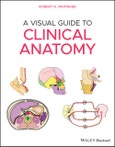A solid knowledge of anatomy is essential within any number of fields throughout healthcare. A core discipline of all medical degrees, anatomy is generally taught in a series of laboratory sessions and lectures, requiring students to identify a particular organ or structure, explain its function and describe its relation to normal physiology. Students are expected to learn - and practicing clinicians required to remember - an enormous amount of anatomical information.
A Visual Guide to Clinical Anatomy is an extraordinary visual reference guide, containing more than 900 high-quality illustrations of the human anatomy. Author and illustrator Robert H. Whitaker draws upon his 30 years of experience as an anatomy demonstrator and lecturer at Cambridge University to present a simple, easy-to-understand approach to both teaching and learning the subject. Each illustration is designed to provide a summary of key anatomical and clinical information of a specific topic or clinical condition. A comprehensive yet user-friendly anatomy resource, this volume:
- Covers the major areas of human anatomy
- Provides succinct, clinically relevant information for each illustration
- Offers clear and accessible synopses of anatomical structures
Table of Contents
Preface vii
Robert H. Whitaker
Foreword ix
By Professor Harold Ellis
Foreword xi
By Professor Sir Roy Calne
About the Author xiii
Section 1: Upper Limb 1
1.1 General Anatomy 2
1.2 Shoulder and Arm 13
1.3 Axilla, Brachial Plexus and Nerve Lesions 31
1.4 Elbow and Forearm 52
1.5 Wrist and Hand 62
Section 2: Lower Limb 81
2.1 Nerves, Vessels and Lymphatics 82
2.2 Gluteal Region, Hip and Thigh 99
2.3 Knee and Popliteal Fossa 116
2.4 Lower Leg 125
2.5 Ankle and Foot 132
Section 3: Thorax 147
3.1 Surface Anatomy and Breast 148
3.2 Mediastinum, Thoracic Inlet, Diaphragm and Lymphatics 159
3.3 Heart and Pericardium 166
3.4 Trachea, Lungs and Oesophagus 187
3.5 Vessels and Nerves 200
3.6 Cross Sections 207
Section 4: Abdomen and Pelvis 215
4.1 Surface Anatomy and Hernia 216
4.2 Peritoneum, Vessels and Nerves 230
4.3 General Bowel Anatomy and Foregut 239
4.4 Midgut and Hindgut 251
4.5 Biliary System, Portal System, Pancreas and Spleen 265
4.6 Female and Male Genitourinary and Renal Tracts 277
4.7 Pelvis and Perineum 298
4.8 Referred Pain and Autonomics 312
Section 5: Head and Neck 325
5.1 Skull Bones, Air Sinuses and Scalp 326
5.2 Brain, Spine, Spinal Cord and Vessels 335
5.3 Intracranial Haemorrhages 350
5.4 Cranial Nerves in General and Skull Foramina 354
5.5 Cranial Nerves I, V, VII 364
5.6 Cranial Nerves VIII, IX, X, XI, XII 372
5.7 Rules and Nerve Supply of Muscles 379
5.8 Eye Visual Pathways, CN III, IV, VI, Autonomics and Oculomotor Versus Horner’s 385
5.9 Eye Lids, Orbit, Lacrimal Gland, Retina and Optic Nerve 391
5.10 Eye Light and Near Reactions, Eye Movements and Pupil Control 398
5.11 Outer, Middle and Inner Ear 406
5.12 Mouth and Mandible 413
5.13 Nose and Face 424
5.14 Neck Fascia, Vessels and General Anatomy 430
5.15 Neck Triangles, Muscles, Thyroid and Parathyroid Glands 440
5.16 Parotid and Submandibular Glands 448
5.17 Larynx and Pharynx 452
5.18 Autonomic Nervous System, in General, Sympathetic and Parasympathetic 464
5.19 Temporal, Infratemporal and Pterygopalatine Fossae 481
5.20 Cavernous Sinus and other Venous Sinuses 489








